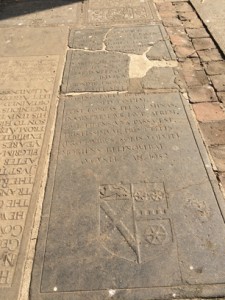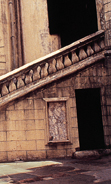Registered with the Registrar of Newspapers for India under R.N.I 53640/91
Vol. XXV No. 13, October 16-31, 2015
Know your Fort better

Elizabeth Baker’s tombstone
Before you walk into the Church of St Mary’s and admire its treasured possessions, pause for a while and look around the yard. It is paved with some of the oldest British tombstones in India. All of them rectangular, several of them broken and re-assembled like a jigsaw, these have a story of their own to tell, for some of them date to a time when St Mary’s was not yet thought of.
A high rate of mortality was one of the features of early colonial life in India and, today, the sole remnant in many abandoned settlements is a graveyard. Madras is different, for its first British graveyard has completely vanished, the Law College standing on that site now. The early records speak of ‘the English Golgotha or Place of Sculls’ as having been near “the North West angle of the Native Town” – not to be confused with present day George Town but the old Black Town which straggled to the rear of the Fort and occupied much of what we would today recognise as the High Court Campus. A vast guava garden existed west of this spot and from Dr Fryer’s writings based on his stay in the city in 1673, we do know that the last resting place of the first English settlers here was no open yard but an enclosure with distinctive architectural features. H D Love, in his Vestiges of Old Madras (1913), has it that the tombs ”occupied the floor of a long battlemented cloister. This had arches on each side, supported by pillars, which also carried a vaulted roof. The roof consisted of a series of domes, each dome rising from a square base of four columns, and terminating in a ball carrying ornamental iron work”. The last named has been described by Dr Fryer as a globe riveted by ”an iron wedge sprouting into a Branch”. All the monuments and funerary slabs were of Pallavaram gneiss, the local stone.
In 1680, when Streynsham Master was in charge of Madras, the burial ground was cordoned off from the rest of the guava garden by a wall. The garden itself was handed over for development and on it came up Garden and Merchant Streets, Merchant Lane and Back Lane, none of which survive now. Arriving in Madras in 1702, Charles Lockyer penned a detailed account of our city and in it also included a description of the burial place, which, according to him, was “adorn’d with many stately Tombs in honour of the Defunct. Some with lofty Spires carved into different Fancies, after the Indian manner; others in a lower Sphere gravely express the Merits of the Person for whose sake they were erected; and all in general have the most curious Workmanship in India bestow’d on them.” Lockyer also evidently attended a couple of burials there and recorded that “When a Person of Note dies, his Funeral is solemnised with the greatest Magnificence. The Governour, Council, and Gentlemen of the Town attend; nor are the fair Sex wanting in their Duty to their deceas’d Countryman.”
Even after the construction of St Mary’s, burials continued to happen at this designated place, outside the Fort. In 1711, John Legg, Member in Council and whose wife Hannah would be buried in the guava garden six years later, wrote that the place had some old toddy trees (probably palmyrah palms) which gave the Church an annual income of twenty pagodas. Even while that note was being written, the church wardens had begun to complain about the cemetery going to seed. Evidently nothing has changed in our city when it comes to use of public spaces. The toddy tappers worked whenever they felt like and the gates had to be kept open at all odd hours. The tombs had become stables for buffaloes and night shelters for beggars. To prevent ingress of cattle, a shed was built for them close by but within a few months the Company requisitioned that structure for shops and the buffaloes were back at the cemetery.
Worse was to follow in 1758 when the French besieged Madras. A detachment of their troops was stationed at the burial ground. A battery was erected behind the convenient shelter that the tombs provided and from this, and other locations, the bombardment of the Fort began. When the siege was lifted, a thorough study of the Fort’s security was made by John Call and in it he noted that the officers suffered “great Inconvenience from the Tombs at the burying Ground, which, being large arch’d Structures placed in a line, almost close to each other and opening into one another, not only protected the Enemy from our shot, but afforded them a cover equally safe against our Shells.” He requested that the Council “be pleas’d to give Orders for removing this Evil.”
His words bore fruit and the tombs and enclosure walls were levelled, even as the inscribed stones were transferred to the yard around St Mary’s Church in the Fort. Two monuments were left standing. One was the Yale Obelisk, a giant piece of masonry beneath which rest Elihu Yale’s son David, and Yale’s close friend Joseph Hynmer. Alongside was a circular vault enclosed with a railing and this contained the remains of six members of the Powney family. Today, the latter is untraceable, probably sacrificed in the interests of the Metrorail. Even by the early 1800s, all memory of the old burial ground had gone and people considered the Yale and Powney monuments to be isolated structures. It was only when excavations for the Law College began in the 1880s that quantities of bones were discovered, leading to renewed interest in the Guava Garden Cemetery.

Agent Greenhill’s tombstone
The transfer of the stones took time, for Hyder Ali, while invading Madras in the 1780s, could still use them for mounting his guns. Several stones were thus damaged and many vanished and only a small selection made their way to the Fort. Joining them in the St Mary’s yard were stones from the old Capuchin church of St Andrew’s which had stood within the Fort and was demolished in 1749 after its priests were suspected of colluding with the French. Interestingly, there is a tomb with a Tamil inscription as well. This commemorates Thaniappa Mudaliar, alias Lazarus Timothy. A dubash of the French East India Company, he belonged to the parish of the Capuchin church and when he died in 1691, was buried there. We thus have a Tamil Catholic who worked for the French EIC, commemorated in the yard of the oldest Anglican church!
Also of interest is the tombstone of Elizabeth Baker, wife of Aaron Baker who was Agent, and later first President of Madras in the 1650s. She died off the Cape of Good Hope in 1652 and her body was brought to Madras for burial. The tombstone has the distinction of being the oldest surviving British inscription in India. One multicoloured stone alone has been let into the north wall of the Church. This commemorates Agent Henry Greenhill, who died in 1658 under what can only be described as curious circumstances. He being “much Sweld, was perswaded per the Surgeons to bee tapt, to let out the Beaveridge, after which hee lived but two days.” Such being the mercenary temper of the times, the same note in the next sentence records that it is an ill wind that blew nobody any good, for his death meant that Thomas Chamber, who succeeded him, “will bee Exalted into a better Capacity of serving his friends.” Such is life.
A full description of every tombstone in the yard (there are 104 of them) is to be found in J Cotton’s work, the Monuments of Madras. This in turn draws many references from two earlier works. The first is Urquhart’s Oriental Obituary, published in 1809 in Madras, which records many stones now missing. The second dates to 1880 and is an album prepared at the instance of the then Governor, the Duke of Buckingham and Chandos, of the facsimiles of all the stones lining the yard of St Mary’s in the Fort.

